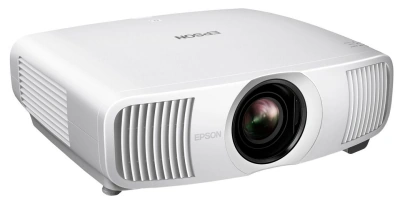Epson’s Home Cinema line of projectors bring theater-level quality and big-screen entertainment into everyday homes at an excellent value. If you’re looking at the Epson LS11000 vs. 5050UB, the question of which one is better comes down to your budget and picture needs. Based solely on performance, the Epson LS11000 is the better projector, with a sharper resolution, better lens, and more advanced image processing. That said, the Epson 5050UB has an MSRP that’s around $1,000 lower, making it an outstanding value for the performance it offers. Let’s take a closer look at the details.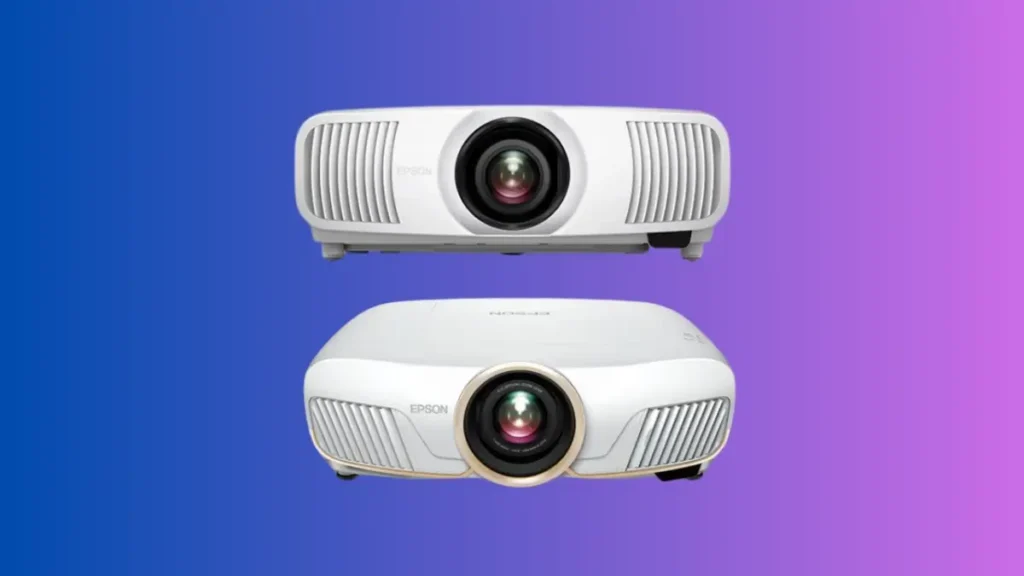
In This Comparison:
- Specs
- Design and Build
- Installation and Space Requirements
- Image Quality
- Gaming Performance
- Value
- Epson LS11000 Overview
- Epson 5050UB Overview
- Verdict
Epson LS11000 vs. 5050UB Specs Side by Side:
Design and Build
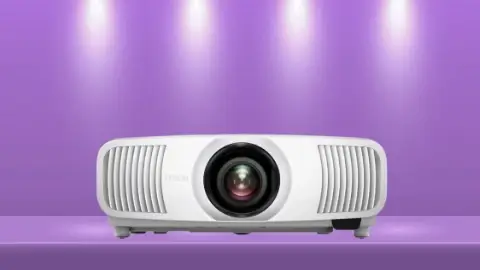
After having the pleasure of examining both the Epson Home Cinema LS11000 and the Home Cinema 5050UB projectors side by side, it’s immediately clear that their design philosophies are strikingly alike, but with subtle distinctive features. Aesthetically, both projectors exude a sense of familiarity. The LS11000 boasts a silver-tinted ring around its lens, while the 5050UB flaunts a gold-tinted ring, adding a touch of luxury and distinction to each model. Further enhancing their versatile appeal, both are available in white and black finishes, catering to diverse preferences and room setups. In terms of measurements, the LS11000 and the 5050UB are nearly identical, with both spanning approximately 20.5″ in width. The LS11000 measures 17.6″ in depth, just a smidgen less than the 5050UB’s 17.7″. They share the same height, standing at 7.6″. When it comes to weight, there’s a noticeable distinction. The LS11000 has a heftier feel, weighing in at 28.0 lb, while the 5050UB is slightly more svelte at 24.7 lb.
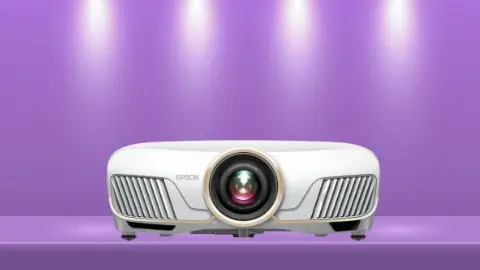
Better Design: a Tie
Image Quality

We were genuinely impressed with the visual performance of the Epson 5050UB. Its pixel-shifted resolution showcases an admirable clarity, offering roughly double the on-screen pixels compared to full HD. The inclusion of automatic iris adjustment paired with the UltraBlack technology is a game-changer, as it significantly enhances the contrast. Its 3-chip color system is impeccable, flawlessly rendering the full DCI-P3 spectrum, and with the assistance of HDR10 and Low Delta E technology, the color accuracy is spot-on.
Check the Latest Price on Amazon Now!
On the other hand, when it came to raw resolution, the Epson LS11000 clearly took the lead. Our tests revealed its pixel-shifting engine to be more technologically advanced, delivering a genuine 4K resolution. This, coupled with a superior lens design, resulted in a noticeably crisper overall image. What further distinguished the LS11000 was its real-time adaptive correction; it seamlessly adjusted both color and contrast based on the content, ensuring that movies and shows were always viewed in peak quality.

Higher image quality: Epson LS11000
Gaming Performance

The Epson LS11000 can be used by most gamers. It can produce 120 frames per second for either full HD or 4K content, meaning super-smooth movement on the screen. While it advertises an input lag of under 20ms, however, the measured input lag in most image modes is in the 30-40ms. That’s low enough most players won’t have a problem, but can be an issue for serious players of reflex-based games.

While the Epson 5050UB has a lower frame refresh rate, it still hits the 60 frames per second metric gamers look for. More importantly, its input lag is consistently lower, measuring between 20ms and 30ms across image settings. In truth, these projectors are very close in this regard—either one can work for casual gaming, and neither will be the preferred model for a professional gamer. Generally speaking, though, the lower lag of the 5050UB will make it the superior option.
Better gaming performance: Epson 5050UB
Installation and Space Requirements

The Epson LS11000 and 5050UB have very similar performance when it comes to installation and space flexibility. They have a similar throw distance and lamp brightness, with both best-suited to relatively large space with low to moderate ambient light. Each also offers a 3-axis motorized lens, giving them options like lens shift and a powered zoom that make them more adaptable to a variety of setups.
Where the Epson LS11000 comes out ahead is its option of 10 lens memory preset slots. This means users can save their lens settings and quickly switch between them, a very helpful feature if you’ll be using your projector in multiple spaces or environments.
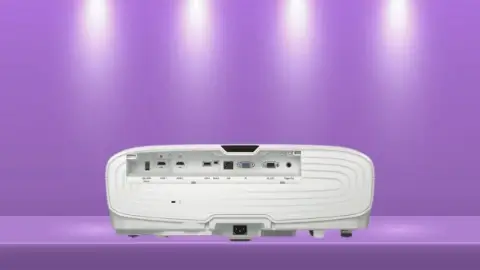
Easier installation: Epson LS11000
Value
The Epson 5050UB was released in April 2019 with an MSRP of just under $3,000. The Epson LS11000 is both newer (released in March 2022) and had a higher list price to start. While its higher price makes sense given its improved lens, superior pixel shifting technology, and other upgrades, 5050UB is a great value for its performance, especially since you’re more likely to find it on sale for less than the list price.
Better value: Epson 5050UB
Individual Reviews:
Epson LS11000: A Closer Look
The Epson LS11000 uses a superior version of Epson’s pixel shifting technology. It has a digitally controlled Precision Shift Glass Plate and ZX Picture Processor that work with the 3-chip LCD engine to generate a true 4K image with a full 8.3 million on-screen pixels. The 15-element VRX Cinema Lens further enhances the clarity and ensures a uniform focus across the picture. Add in the high dynamic contrast ratio and you have a sharp, highly-detailed image for all kinds of content.
That 3LCD display, combined with the powerful multi-array laser light source and the 10-bit HDR color processing, produces remarkably vibrant and realistic colors with none of the brightness inconsistency or rainbowing that can be caused by single-chip projectors. The ZX processor also provides real-time color and contrast correction on a scene-by-scene basis, automatically optimizing the picture to what’s ideal for the content. The LS11000 is responsive, too, playing 4K content at 120 frames per second and a reasonable input lag for casual gamers.
The Epson LS11000 is relatively easy to set up and use, as well. While it does have a fairly long throw distance, the motorized lens has a robust lens shift option (+/-96% horizontal and +/-47% vertical) with a 2.1x powered zoom, giving it good flexibility within that space. The main thing to keep in mind is that the LS11000 does best in entertainment systems using a receiver since it will require external speakers and content sources. Related comparison: Epson LS11000 vs LS12000
Pros
- Sharp 4K image with excellent detail and contrast
- Real-time Adaptive Correction
- Wide color gamut with no rainbowing
- Bright enough for most viewing areas
- Flexible installation thanks to motorized lens
- Responsive enough for casual gaming
Cons
- Long throw distance
- Requires other equipment to use (no speakers or streaming)
Epson 5050UB: The Budget-Friendly Powerhouse
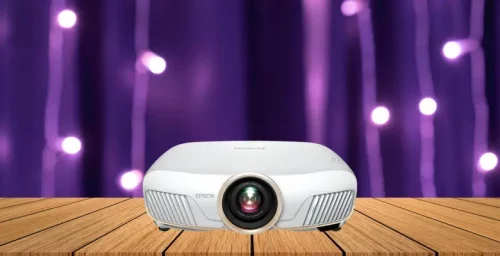 The Epson 5050UB is a great option for gamers who want to play on a big screen. Its measured input lag is under the 30ms threshold you need for reflex-based games and online play. A 60Hz frame refresh rate, combined with sophisticated frame interpolation technology, keeps the on-screen action smooth, too, with no frustrating blur or frame tears that can disrupt your playing.
The Epson 5050UB is a great option for gamers who want to play on a big screen. Its measured input lag is under the 30ms threshold you need for reflex-based games and online play. A 60Hz frame refresh rate, combined with sophisticated frame interpolation technology, keeps the on-screen action smooth, too, with no frustrating blur or frame tears that can disrupt your playing.
The 5050UB supports HLG and HDR10 technology for accurate and realistic color and contrast. Like the LS11000, it uses 3LCD processing to eliminate the risk of rainbowing. The 12-bit color chip produces the full DCI-P3 color gamut, the current professional cinema standard, with Low Delta E to ensure the accuracy of the hues. The main difference here is the pixel-shift processor. The 5050UB uses an older technology than what’s included in the LS11000, so while it has a resolution higher than full HD it doesn’t quite reach the level of 4K resolution. Related comparison: Epson LS12000 vs 5050UB
Buy with One-Click on Bhphotovideo.com
As far as installation and operation, the Epson 5050UB has similar strengths and weaknesses to the model above. Its powered lens has a 2.1x zoom, powered focus, and a 2D lens shift (+/-47.1% horizontal and +/-96.3% vertical) that make it easy to install in most spaces. Bear in mind, however, that it also has a fairly long lens shift, so you’ll want to use it in a larger space. It also lacks wireless connectivity or built-in speakers, something to plan for as you’re figuring out your other equipment and overall setup.
Pros
- High-contrast image with resolution sharper than full HD
- Full cinematic color with no rainbowing
- Low lag is great for gaming
- Flexible to install
- Ideal brightness for most indoor spaces
- Automatic iris brightness adjustment
Cons
- Lower image resolution
- No adaptive color or contrast technology
Verdict
As is often the case, choosing the right projector means first deciding what you need in your home entertainment space. The Epson LS11000 produces a better image with sharper resolution, and has other convenience upgrades you won’t find on the Epson 5050UB, making it the better choice for most. On the other hand, the Epson 5050UB has slightly better gaming performance, with a lower price tag that can make it an appealing option for budget-conscious buyers.
